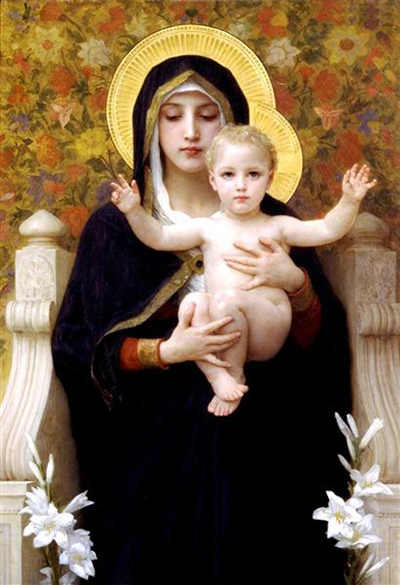The Madonna of the Lilies painted in 1899 by William Adolphe Bouguereau (1825-1905).
This beautiful depiction in the Realism style is full of life and movement, drawing your eye instantly to the young mother holding her babe.
The Madonna of the Lilies depicts Mary as a seated figure, a pose which has been favoured in religious iconography since the fifteenth century. The child is lovingly supported by his mother while his arms reach out to the viewer. White lilies placed around her throne symbolise chastity and purity.
The technique of building up the colours, layer by layer, gives a special quality to all Bouguereau’s paintings. The characters have both warmth and humanity. In ‘The Madonna of the Lilies’ the child is calmly looking out into our world.
Note the flowers in the background which complete the picture without drawing attention away from the mother and child.
While only a small number of Bouguereau’s paintings have a religious theme, these include several depictions of the Madonna. ‘The Madonna of the Roses’ is a later work with the same subject. He studied the Renaissance artists in his youth and may have been impressed by their emphasis on religious iconography.
Bouguereau spent his teenage years with his uncle in Mortagne sur Girond. He was encouraged to study the classics, including mythology and religion. In addition to this the young Bouguereau had ample opportunity to explore the surrounding countryside where he studied the beauty of nature at length.
These elements made such an impression on the young man that he returned to them again and again in his painting. His output was prodigious and in his prime he produced up to 18 paintings a year.
During the nineteenth century, the role of art was to celebrate humanity. To this end the Naturalists concentrated on reality, the Pre-Raphaelites on legends and the Social Realists on the experiences of the poor.
In 1900 Degas and Monet were asked in an interview to name the artist they thought would be remembered as the greatest nineteenth century painter. Their answer was William Bouguereau.
They could not have foreseen the rise of Modernism and the effect it would have on the arts. Realism was derided as sentimental and unrealistic and many of Bouguereau’s works were put into storage by museums and galleries who felt they were no longer relevant. This situation persisted until the 1980s when art lovers once again began to appreciate the beauty of his work.




